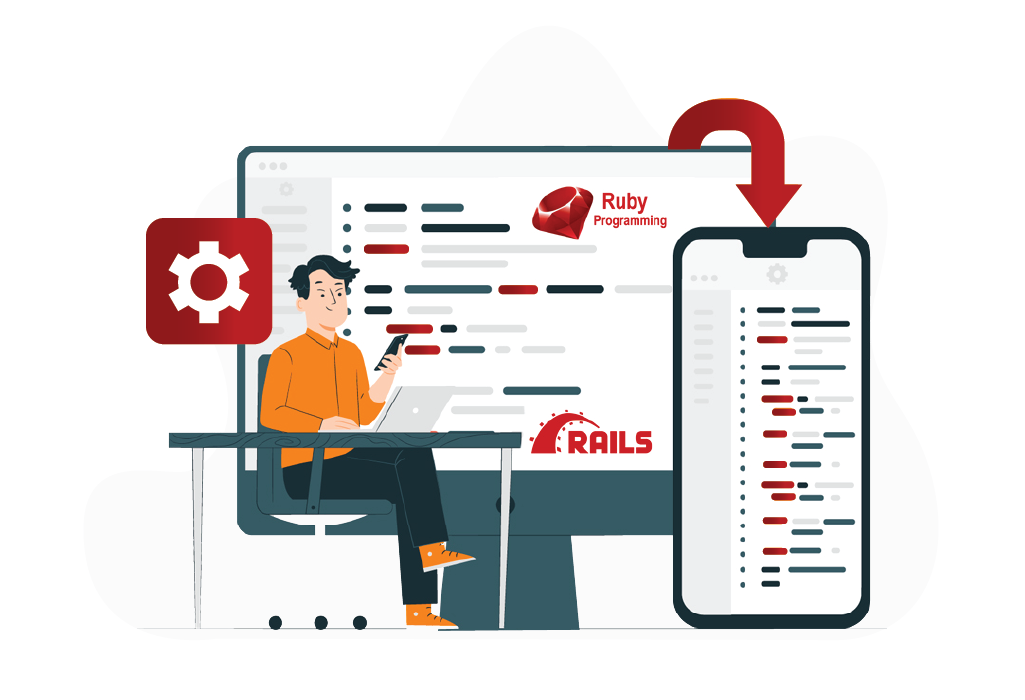Ruby on Rails: Forging Elegance in Web Application Development
Ruby on Rails, often alluded to as RoR or Rails, is a strong open-source web application framework written in the Ruby programming language. It follows the Model-View-Controller (MVC) design pattern, working with the development of dynamic and intelligent web applications. Ruby on Rails performance tuning has gained immense popularity due to its developer-friendly syntax, convention over configuration philosophy, and emphasis on the “Don’t Repeat Yourself” (DRY) principle. This structure empowers developers to compose spotless, succinct, and viable code, supporting efficiency and reducing development time. Ruby on Rails tracks down applications in different industries, from e-commerce and social networking to fintech and healthcare. Its flexibility, versatility, and rapid development abilities make it a superb choice for new businesses, ventures, and individual developers hoping to construct dynamic and feature-rich web applications.
This structure empowers developers to compose spotless, succinct, and viable code, supporting efficiency and reducing development time. Ruby on Rails tracks down applications in different industries, from e-commerce and social networking to fintech and healthcare. Its flexibility, versatility, and rapid development abilities make it a superb choice for new businesses, ventures, and individual developers hoping to construct dynamic and feature-rich web applications.
Ruby on Rails has altered web improvement by working on complex tasks, promoting best practices, and empowering developers to make powerful and creative applications. Its elegant design, combined with its dynamic community and broad libraries, has set its position as a favored framework for building modern web applications. Selecting RoR as your development partner won’t ensure the success of your project; adequate care and attention are needed to manage it successfully. It is essential to optimize your web application in order to gain better Ruby on Rails speed. Let’s examine the factors that require the streamlining of RoR applications:
Spilling the Imperative: Understanding the Necessity to Optimize Your Ruby on Rails App
Optimizing a Ruby on Rails application is a basic move towards guaranteeing its ideal performance, versatility, and user experience. Ruby on Rails, a well-known web development framework, offers rapid development capacities, yet as applications fill in intricacy and user base, performance bottlenecks can arise. Here are a few key justifications for why enhancing a Ruby on Rails performance tuning is fundamental:
Improved User Experience: A sluggish and unresponsive application can baffle clients and lead to high bounce rates. Optimizing Ruby on Rails applications includes smoothing out database queries, limiting server load times, and decreasing front-end rendering delays. By upgrading the application’s responsiveness, clients can partake in a consistent and engaging experience, prompting higher client fulfillment and retention.
Faster Loading Times: Page load speed is a vital factor in holding clients and further developing search engine rankings. Upgrading Ruby on Rails applications includes caching, asset optimization, and leveraging content delivery networks (CDNs). Faster loading times lead to higher conversions and better search engine visibility, driving organic traffic to the app.
Scalability and Handling Traffic Spikes: As the client base develops, the application should deal with increased traffic proficiently. Ruby on Rails development incorporates database indexing, background processing, and load balancing to guarantee the application can scale flawlessly. Handling care of traffic spikes without performance degradation is fundamental for keeping a positive user experience during peak times.
Cost Savings: An optimized Ruby on Rails app consumes less server resources, prompting cost investment funds in facilitating and framework costs. By proficiently using server resources and limiting the requirement for hardware upgrades, organizations can scale more economically as their application develops.
Competitive Edge: Client experience and speed are crucial differentiators in the present cutthroat advanced market. A Ruby on Rails application that is more productive will outflank its slower rivals by drawing in and holding clients all the more effectively. This benefit might bring about expanded market share and enhanced brand recognition.
Security Upgrade: Overhaul your security by inspecting and revising your code, which can help you find and address conceivable security blemishes. A safe application safeguards client information and forestalls potential security blemishes that could affect the organization’s image and bottom line.
Smooth Updates and Maintenance: A web application’s lifespan requires steady updates and maintenance. Due to the cleaner and more coordinated codebase, keeping up with and updating a streamlined Ruby on Rails project is easier. As a result, there are less possibilities that updates may cause clashes or issues.
Essential Tips to Optimize Your Ruby on Rails App
A Ruby on Rails performance tuning speed has to be improved if it is to provide a reliable user experience, improve its search engine rankings, and accomplish flexibility. Listed below are a few essential pointers to support the speed of a Ruby on Rails application:
Efficient Database Queries:
To upgrade database query proficiency, it’s prescribed to utilize eager loading, which brings related information in a single query, thereby limiting the quantity of executed queries. Another indispensable technique is implementing database indexing on frequently accessed columns, speeding up data recovery by enhancing search operations. For complex inquiries, utilizing database views or denormalization can essentially upgrade performance by decreasing the computational load.
Caching:
Caching strategies are fundamental for streamlining application speed. Fragment caching is helpful for caching explicit view portions that are costly to produce. Furthermore, action and page caching can be utilized to store rendered views as static HTML, reducing the processing time for subsequent requests. Low-level caching is valuable for storing frequently accessed data in memory, such as database query results or computed values.
Asset Optimization:
Enhancing asset loading is crucial for faster page rendering. Minification and compression methods can be applied to JavaScript and CSS files, diminishing their size and subsequently developing loading times. Content Delivery Networks (CDNs) play a significant part by serving static resources from servers found nearer to the user, reducing latency. Furthermore, browser caching can be leveraged to instruct the client’s browser to store resources locally, reducing the need to fetch them with every request.
Background Jobs:
Offloading tedious tasks to background jobs through tools like Sidekiq or Resque is fundamental. Asynchronous task handling upgrades application responsiveness and reduces overall request processing time, adding to a seamless client experience.
Use Page Caching and HTTP Caching:
Page caching is beneficial for static pages that don’t change often, as it evades repetitive processing upon each request. Controlling HTTP caching headers, such as “ETag” and “Last-Modified,” permit clients to cache responses, reducing the number of requests to the server.
Optimize Image Assets:
Optimizing image assets includes compressing images to reduce file size without compromising quality. Carrying out responsive images ensures that different image sizes are based on the user’s device, saving bandwidth and boosting loading speed.
Profile and Monitor Performance:
Routinely profiling the application with tools like Rack Mini Profiler or New Relic is a judicious practice for distinguishing performance bottlenecks. Real-time performance monitoring aids in immediately recognizing irregularities and proactively resolving issues to keep up with optimal performance.
Load Balancing and Scaling:
Executing load balancing proficiently distributes incoming traffic across various server occurrences, promoting balanced resource utilization. Horizontal scaling, achieved by adding more servers to handle increasing traffic, is preferable to solely relying on vertical scaling for improved scalability.
Optimize Database Usage:
Productive database connection pooling to manage connections productively, diminishing the overhead of laying out new connections for each request.. Implementing caching mechanisms like Redis or Memcached supports putting away regularly accessed data, leading to reduced database queries and improved performance.
Regular Code Review and Refactoring:
Conducting routine code reviews helps distinguish and fix performance issues while guaranteeing adherence to best practices. Code refactoring limits code duplication and upgrades code productivity, thereby generally expanding application performance.
Ruby on Rails Performance Tuning: Pioneering Excellence Across Industries
Industry-specific Ruby on Rails development alludes to the utilization of the Ruby on Rails (RoR) framework in building custom-fitted web applications that address the exceptional necessities and challenges of various industries. Ruby on Rails, with its exquisite and developer-friendly syntax, is appropriate for rapid development and prototyping, settling on it as a popular choice for diverse sectors.  This inherent adaptability enables its effective organization in assorted sectors, exhibiting its flexibility and ability.
This inherent adaptability enables its effective organization in assorted sectors, exhibiting its flexibility and ability.
Basically, RoR’s assets seamlessly line up with the particular imperatives of varied enterprises. Its streamlined development cycle combined with striking versatility engages developers to assemble web applications that tackle sector-specific challenges as well as capitalize on unique opportunities. By embracing Ruby on Rails, organizations can productively mold custom solutions carefully custom fitted to their area’s requirements, cultivating innovation and hoisting client experiences to remarkable levels. Here are a few insights into how RoR is utilized in different industries:
E-commerce:
Ruby on Rails finds critical applications in building hearty e-commerce platforms equipped for dealing with significant transaction volumes. Its adaptability, combined with the accessibility of different gems (libraries), works on the execution of perplexing ruby on Rails e-commerce functionalities such as shopping carts, payment gateways, and inventory management. The framework’s secluded design empowers the creation of customizable interfaces, guaranteeing a steady client experience and improving customer engagement. This versatility and measured quality add to the consistent operation of online stores, giving a safe and effective shopping climate for clients.
Fintech and Finance:
Ruby on Rails stands out as a fantastic option for finance platforms and apps. The difficulties of transaction processing, data security, and regulatory compliance are expertly managed by it. In the banking industry, where data security and regulatory compliance are of the highest significance, its thriving community provides ongoing updates and security enhancements. This framework provides a solid foundation for the creation of reliable and secure financial solutions, which improves the efficiency of various financial services and transactions.
Medical Services:
Ruby on Rails offers a robust development environment for the healthcare industry, where security, flexibility, and compliance are essential requirements. Its features, notably stringent parameter protection, and data sanitization, assure data integrity and HIPAA compliance. The framework’s consistency in adaption makes it suited for managing rising user traffic and growing patient information in healthcare applications. By using Ruby on Rails, medical services may offer efficient and secure digital solutions that improve patient care and speed up administrative processes.
Tourism and Travel:
Ruby on Rails makes it possible to create feature-rich travel portals, booking systems, and travel guides. Designing multilingual apps that appeal to a worldwide audience is made simpler by its support with limiting and internationalization. Because of how quickly Minimum Viable Products (MVPs) can be created using the framework, quick testing of new concepts and ideas is made possible. The travel and tourism sector can provide simple and comprehensive systems that make it easy for customers to plan and book their trips thanks to Ruby on Rails.
Education:
For creating e-learning platforms, student management systems, and educational portals, Ruby on Rails is a well-liked option. Because of its speedy development capabilities, educational institutions may start online learning projects more quickly, increasing access to education. Because of the framework’s adaptability, educational platforms may support an increasing number of students and courses, creating a scalable and effective environment for both teachers and students. By enabling dynamic and interesting learning opportunities for students everywhere, Ruby on Rails advances digital education.
Closing the Code: Concluding the Journey with Ruby on Rails
As the digital landscape evolves, RoR web development continues to leave a permanent imprint on different businesses. Its versatility is apparent across areas, from e-commerce and finance to healthcare, tourism, and education. The framework’s rapid development capabilities and modular design empower developers to address sector-specific challenges and capitalize on unique opportunities, cultivating development and raising client encounters. Upgrading a Ruby on Rails application is central for guaranteeing ideal execution, versatility, and user satisfaction. By carrying out methodologies, such as efficient database queries, caching mechanisms, asset optimization, and background jobs, developers can improve loading times, handle traffic spikes, and reduce server costs. These endeavors additionally add to further developed security and smooth support.
RoR’s influence on different industries is noteworthy. Fundamentally, Ruby on Rails keeps on molding current web improvement by offering a harmony between rapid development and robust functionality. Its flexibility, joined with its dedication to streamlining and transformation, guarantees that it stays a favored decision for different industries looking for dynamic, proficient, and innovative web applications. As technology advances, RoR’s impact is supposed to persevere, driving excellence and advancement across a multitude of sectors.
Proclaiming Excellence: Choose Pattem Digital for Ruby on Rails Development Services
With a demonstrated history of delivering innovative and custom-made RoR solutions, Pattem Digital remains as a trusted partner in creating dynamic web applications that reclassify industry norms. Our group of exceptionally gifted developers has a profound comprehension of RoR’s complexities, empowering us to smooth out development processes, enhance execution, and make vigorous, versatile applications. By picking our Ruby on Rails development company, you’re deciding on top-level technical proficiency as well as a partner devoted to understanding your vision, guaranteeing optimal functionality, and driving unrivaled user experiences through the power of Ruby on Rails.


